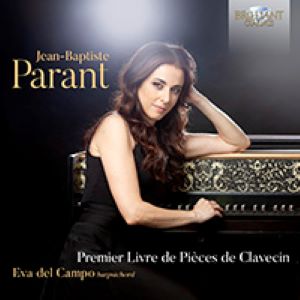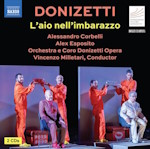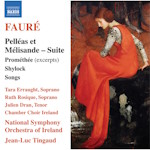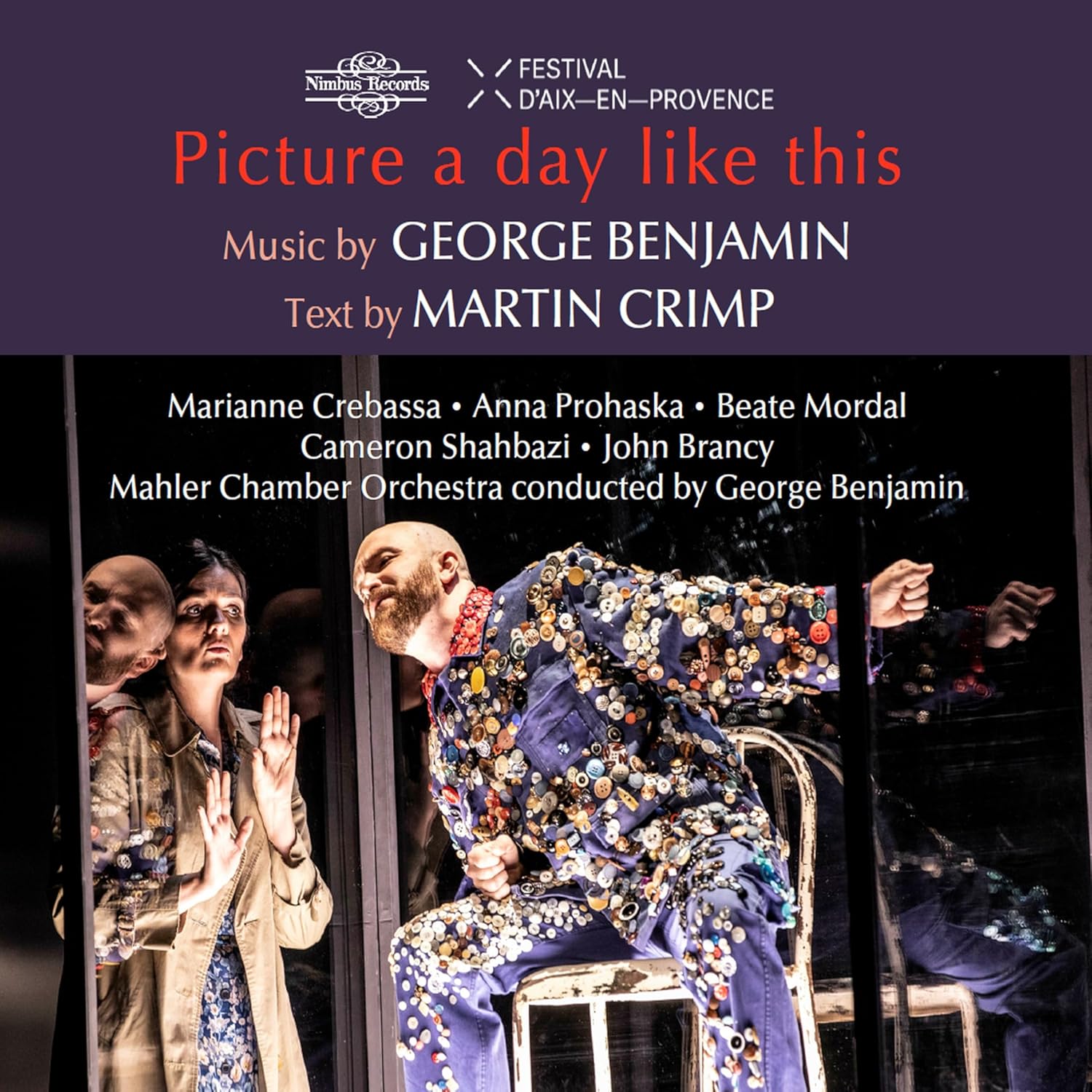
Jean-Baptiste Parant (c.1730-c1780)
Premier Livre de Pièces de Clavecin (c. 1762)
Eva del Campo (harpsichord)
rec. 2022, Girona, Spain.
Brilliant Classics 96854 [66]
Virtually no certain biographical information is known about Jean-Baptiste Parant. We don’t know where he was born or when he died. His only surviving publication is his Premier Livre de Pièces de Clavecin. The date of this collection is only known (with reasonable confidence) because the copy of the book in the Bibliothèque Nationale has the date 1762 hand-written at the foot of the title page. That same title page tells us two other things: the composer is described as “Organiste des Quatre-Vingt” (this being a hospice for the blind, supposedly established by Louis IX in the 1200s) and the book is dedicated to “Mademoiselle d’Harcourt De Beuvron”. The reference is to Louise Angélique d’Harcourt, who was the daughter of the fourth Duke of Harcourt. In the booklet notes (by Eva del Campo and Guillermo Turina, we read that “the earliest information attesting to Monsieur Parant’s musical activity places him in Paris in the year 1759 as harpsichord accompanist at the vocal school attached to the Opéra de Paris under the direction of Jean-Féry Rebel and François Francœur, masters of music to the king”; in 1774 he was promoted to the post of music at the vocal school.
The identity of some of the patrons in whose environs Parant moved are hinted at in the titles of the sixteen pieces making up his Premier Livre de Pièces de Clavecin. A title which standsout is that of No.12 ‘Les Festes de Passy’. Unmistakably, this alludes to the Chateau of Passy, which was occupied by the enormously rich Alexandre La Riche de La Pouplinière (1693-1782) one of the most lavish French patrons of the arts in the Eighteenth Century – see G. Cucuel, La Pouplinière et la musique de chambre au XVIIIe Siècle, Paris, 1913 and J-G Proudhomme and Theodore Baker, ‘A French Maecenas of the Time of Louis XIV: M. de La Pouplinière’, The Musical Quarterly, 10.4, 1924, pp. 511-531. La Pouplinière acquired the Château de Passy in 1647- he seems to have rented, rather than bought the property. He separated from his first wife soon after and took up residence in the Château, which had a private theatre in which operas and ballets were performed. An orchestra was maintained there, which was led by Rameau for more than two decades – Stamitz being one of his successors. Parant’s piece suggests that he benefitted from the support of Alexandre La Riche de La Pouplinière, or perhaps it represents a desire for such patronage.
According to the booklet notes “there are […] mentions of Parant in various cultural publications throughout the 1760s and the early 1770s. The most interesting of these is found in the Mercure de France in January 1762, in an advertisement for his Livre de pieces de Clavecin with following short review; ‘These pieces struck us as agreeable and full of song, a virtue that regrettably is becoming rather rare and which can no longer be commonly ascribed’”.
The booklet notes refer to Parant’s pieces as being in “the light and carefree rococo style”. I have never found ‘rococo’ to be a very useful term, so far as music is concerned. It is hard to separate the term from its use in the decorative arts; ‘galant’ is perhaps better. The qualities of ‘galant’ music, so far as I understand the term, include grace and fluidity as part of a rejection of the complexities of the high baroque. The entry on the ’galant’ by Daniel Heartz and Brice Alan Brown in Volume 21 of the New Grove, pages 430-432, cites Voltaire’s observation that “being galant, in general, means seeking to please”, which seems to apply to the pieces in Parant’s Premier Livre de Pièces de Clavecin. They suggest that the galant idiom freed composers from the contrapuntal fetters of the church style” and they find examples of the style specifically in the “the third quarter of the [Eighteenth] century” – precisely when Parant was composing his pieces for the harpsichord. The return to simplicity, characteristic of the ‘galant’ style, is evident in Parant’s work, as are the ‘song-like’ elements. Parant seems to me to have been more than a little influenced by the harpsichord works of François Couperin, perhaps especially by his character pieces, such as ‘La Fleurie ou La Tendre Nanette’, as well as by the example of Jean-Philippe Rameau.
By the time of Parant’s active career as a composer for the harpsichord, the great school of French keyboard composers was in decline. Parant belongs with composers such as Claude Balbastre (1724-1799), Jacques Duphly (1715-1789), Michel Corrette (1707-1795) and Jean-François Taprey (1738-1822) – composers who continued to write for the harpsichord, even as it slowly gave way to the fortepiano.
At its best Parant’s music is vivacious and full of energy and, as noted by the anonymous reviewer quoted in the Mercure de France (see above), “full of song”. Some of his pictorial pieces, such as ‘Les Cascades’ – which is surely a response to an artificial waterwork in the gardens of a grand house rather than to a natural phenomenon – captures very attractively the repeatedly interrupted flow of water, and it gets an insightful performance from the excellent Eva del Campo. Elsewhere, Parant’s menuets have all the appropriate stateliness – a kind of unstuffy dignity. Parant was obviously fond of the rondeau, it being the dance form familiar from French suites which he uses most frequently, and which he handles with considerable elegance and invests with a distinct personality. His character pieces are often entertaining – notably ‘La Angôt’, presumably an aristocratic lady who the composer had encountered, and ‘La Pétulante’, an affectionate, and only gently satirical portrait of a short-tempered aristocratic lady.
There is a plenty on this disc which will be enjoyed by aficionados of French harpsichord music. Parant’s work is not especially innovative, but neither is he a slavish imitator of earlier masters. Eva del Campo’s playing is well-judged and sympathetic. She plays an instrument made by Martine Argellies, described as a “Franco-Flemish double manual harpsichord […[ after Rűckers-Taskin”. Presumably this was originally a Flemish instrument, made by one of the Rűckers family, and was later remodelled and expanded by either Pascal-Joseph Taskin (1723-1793) or his son Pascal-Joseph Taskin II (1750-1829). This procedure was so common that it had a name of its own, being known as Ravelement. The recorded sound, save for a few passages which are rather thick and heavy, is generally good.
This is the first complete recording of Jean-Baptiste Parant’s Premier Livre de Pièces de Clavecin and deserves a warm welcome.
Glyn Pursglove
Contents
La D’Harcourt
La Angôt,
La De Monpesat’s (Rondeau) Suitte de la Demonpesat
Première Gavotte, in G major; 2nd Gavott
Les Cascades
Menuet
La Debonne Val (Rondeau)
La Majestueuse (Allemande)
La Pétulante
La De La Bauve (Rondeau) in A minor;
Suitte de la Bauve Menuet
Les Festes de Passy (Rondeau)
La Follette
Minuet
La De Beuvron
La Lionoise
Buying this recording via a link below generates revenue for MWI, which helps the site remain free




















